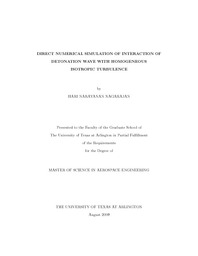
ATTENTION: The works hosted here are being migrated to a new repository that will consolidate resources, improve discoverability, and better show UTA's research impact on the global community. We will update authors as the migration progresses. Please see MavMatrix for more information.
Show simple item record
| dc.contributor.author | Nagarajan, Hari Narayanan | en_US |
| dc.date.accessioned | 2009-09-16T18:19:04Z | |
| dc.date.available | 2009-09-16T18:19:04Z | |
| dc.date.issued | 2009-09-16T18:19:04Z | |
| dc.date.submitted | January 2009 | en_US |
| dc.identifier.other | DISS-10303 | en_US |
| dc.identifier.uri | http://hdl.handle.net/10106/1733 | |
| dc.description.abstract | The propagation of a shock or detonation wave through a reactive mixture has been the subject of research for over a century. The basic understanding has been shaped by one-dimensional Euler models, namely, those of Chapman-Jouguet and Zeldovich-Neumann-Doring, despite the fact that the detonation front is multidimensional. Other complications include observations of detonation instability, and spinning and galloping detonations. Recent advances in CFD have made it possible to examine detonation waves in great detail. These studies have revealed the complex nature of detonations that were observed experimentally. Some outstanding issues include the influence of inhomogeneities in the reactive mixture on the detonation process, such as the formation of hot spots. The understanding of such phenomena has practical implications, including in safe handling of fuels and in promoting detonations for detonation engines. The current research is to comprehend the interaction of a detonation wave with a homogeneous isotropic turbulent field by solving three dimensional reactive Navier--Stokes equation using direct numerical simulation. 5th order WENO scheme and 3rd order Runge Kutta technique are employed. The interaction of detonation wave with turbulence resulted in higher amplification of turbulence statistics (such as turbulent Mach number, turbulent length scales, rms of the velocity, etc). The study also revealed that there is an increase in turbulent kinetic energy in the range of wave number relevant to moderate and small scales. Investigation on the effect of heat release indicated that these changes are directly proportional to the heat release. The examination also involved the study relevant to the influence of the length scale which indicated that the changes in turbulence are proportional to the length scale. | en_US |
| dc.description.sponsorship | Lu, Frank | en_US |
| dc.language.iso | EN | en_US |
| dc.publisher | Aerospace Engineering | en_US |
| dc.title | Direct Numerical Simulation Of Interaction Of Detonation Wave With Homogeneous Isotropic Turbulence | en_US |
| dc.type | M.S. | en_US |
| dc.contributor.committeeChair | Lu, Frank | en_US |
| dc.degree.department | Aerospace Engineering | en_US |
| dc.degree.discipline | Aerospace Engineering | en_US |
| dc.degree.grantor | University of Texas at Arlington | en_US |
| dc.degree.level | masters | en_US |
| dc.degree.name | M.S. | en_US |
| dc.identifier.externalLink | http://www.uta.edu/ra/real/editprofile.php?onlyview=1&pid=274 | |
| dc.identifier.externalLinkDescription | Link to Research Profiles | |
Files in this item
- Name:
- Nagarajan_uta_2502M_10303.pdf
- Size:
- 11.16Mb
- Format:
- PDF
This item appears in the following Collection(s)
Show simple item record


